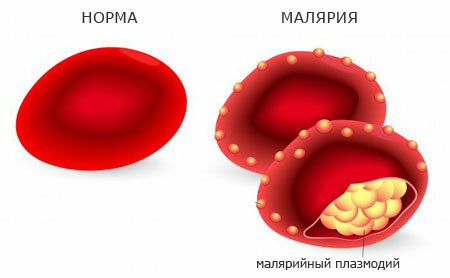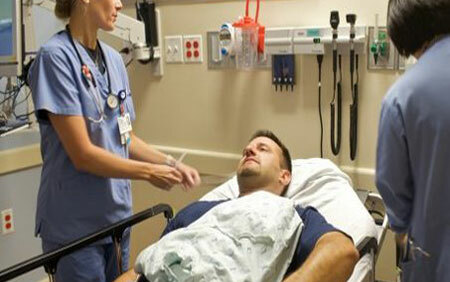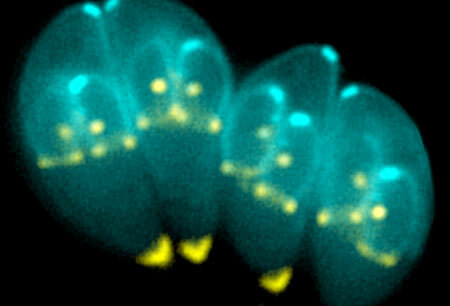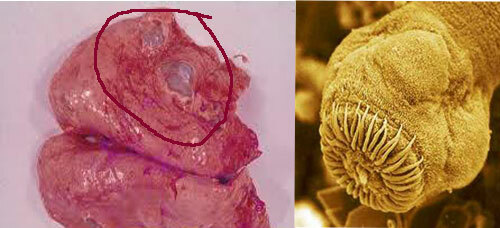What is this disease? Malaria is a group of diseases caused by a simple parasite( malarial plasmodium) and transmitted through the blood( transmissible pathway) with the bites of a female malarial mosquito.
Accompanied by fever, chills, enlarged spleen and liver, anemia. A characteristic feature of this protozoal invasion is the cyclicity of the clinical course, i.e.periods of improvement in well-being are followed by periods of dramatic deterioration with a high temperature rise.
The disease is most common in countries with hot climates. This is South America, Asia and Africa. According to the World Health Organization, malaria poses a serious medical problem for 82 countries in which the death rate from this infection is very high.
The urgency of malaria for a Russian person is due to the possibility of infection during tourist trips. Often, the first symptoms appear already upon arrival at home, when a person has a fever.
Without fail, when this symptom occurs, you should inform your doctor about your journey.this will facilitate the establishment of the correct diagnosis and save time.
Contents
- 1 Causes, clinical picture of the disease
- 2 Symptoms of malaria
- 3 Malaria diagnosis
- 4 Malaria treatment methods
- 5 Malaria prevention
- 6 World malaria day
Causes, clinic of the disease

Malaria plasmodium is the causative agent of malaria. It belongs to the class of protozoa. Causative agents may be 4 species of plasmodia( although there are more than 60 species in nature):
- R. Malariae - leads to malaria with a 4-day cycle;
- P.vivax - causes malaria with a 3-day cycle;
- R. Falciparum - causes tropical malaria;
- R. Ovale - causes the oval-shaped three-day malaria.
In endemic countries, a mixed infection is often observed. It is characterized by the simultaneous infection of several species of plasmodia. When parasitological research, they are detected in the blood.
The life cycle of malarial plasmodia involves the successive change of several stages. In this case, the hosts change. At the stage of schizogony, the pathogens are in the human body. This is a stage of asexual development, it is replaced by the stage of sporogony.
It is characterized by sexual development and occurs in the body of the female mosquito, which is the carrier of the infection. Causal mosquitoes belong to the genus Anopheles.
The penetration of malarial plasmodium into the human body can occur at different stages in different ways:
- When bitten by a mosquito, infection occurs at the sporotoon stage. Penetrated plasmodia in 15-45 minutes are in the liver, where their intensive multiplication begins.
- The penetration of the plasmodium of the erythrocyte cycle at the schizonic stage occurs directly into the blood, bypassing the liver. This pathway is realized with the introduction of donor blood or when using non-sterile syringes that can be infected with plasmodia. At this stage of development, it penetrates from the mother to the child in utero( the vertical route of infection).This is the danger of malaria for pregnant women.
In typical cases, the division of plasmodium, which enters the body with a mosquito bite, occurs in the liver. Their number increases many times. At this time, clinical manifestations are absent( incubation period).
The duration of this stage is different depending on the type of pathogen. It is minimal in R. Falciparum( from 6 to 8 days) and is maximal in P. melariae( 14-16 days).
Symptoms of malaria

The characteristic symptoms of malaria are described by a known triad:
- paroxysmal( by type of crises) temperature increase, repeated at regular intervals( 3 or 4 days);
- enlargement of the liver and spleen( hepatomegaly and splenomegaly, respectively);
- anemia.
The first symptoms of malaria are nonspecific. They correspond to the prodromal period and show signs characteristic of any infectious process:
- general malaise;
- marked weakness;
- lower back pain;
- joint and muscle pain;
- slight increase in temperature;
- decreased appetite;
- dizziness;
- headache.
A specific increase in temperature develops as a result of the release of plasmodia into the blood. This process is repeatedly repeated, finding reflection in the temperature curve. The cyclicity time is different - in some cases it is 3 days, and in others - 4.
Based on this, the corresponding varieties of malaria( three-day and four-day) are allocated. This is the period of obvious clinical manifestations, when the patient turns to the doctor.
Malaria fever has a characteristic appearance due to a successive change of three phases. In the beginning, the stage of chills( a person can not get warm, despite warm wraps), which is replaced by heat( the second stage).The temperature rises to high values (40-41 ° C).
The attack ends with increased sweating. Usually it lasts from 6 to 10 hours. After an attack a person immediately falls asleep due to a pronounced weakening, which developed as a result of intoxication and muscle contractions.
The increase in the liver and spleen is not determined from the very beginning of the disease. These symptoms can be identified after 2-3 febrile seizures. Their appearance is due to the active multiplication of malarial plasmodia in the liver and spleen.
When infected with blood, anemia immediately appears associated with the destruction of red blood cells( malaria plasmodia is located in them).
At the same time, the level of leukocytes, mainly neutrophils, decreases. Other hematological signs are the acceleration of ESR, the total absence of eosinophils and the relative increase in lymphocytes.

malarial erythrocyte disease, clinic of the disease
These signs indicate the activation of the immune system. She fights infection, but she can not cope. The disease progresses, and the risk of complications increases.
With a certain degree of probability, they can be predicted on the basis of unfavorable prognostic signs. These are:
- fever, observed every day, and not cyclically( after 3-4 days);
- no interinflorous period between seizures( the temperature is constantly determined, which corresponds to subfebrile values between attacks);
- severe headache;
- common seizures, observed 24-48 hours after the next attack;
- a critical reduction in blood pressure( 70/50 mmHg or less), approaching the shock state;
- high level of protozoa in the blood according to microscopic examination;
- presence of plasmodia in the blood, which are at different stages of development;
- progressive increase in the number of leukocytes;
- decrease in glucose is lower than the value of 2.1 mmol / l.
The main complications of malaria are:
- malarial coma, which is more likely to affect pregnant women, children and young people;
- acute renal failure with a decrease in diuresis less than 400 ml per day;
- hemoglobinuria fever, developing with massive intravascular destruction of erythrocytes and the formation of a large number of toxic substances;
- is a malarial algid that resembles a brain damage in this disease, but differs from it in the preservation of consciousness;
- pulmonary edema with acute onset and course( often fatal);
- rupture of the spleen associated with torsion of its peduncle or stagnant phenomena;
- severe anemia due to hemolysis;
- intravascular coagulation of blood within the DIC-syndrome, followed by pathological bleeding.
For tropical malaria, the complications of may be specific:
- corneal involvement;
- opacity of the vitreous humor;
- choroiditis( inflammatory damage of the eye capillaries);
- visual neuritis;
- paralysis of the eye muscles.
Sometimes the term "malaria on the lips" is used. But he has nothing to do with the disease in question. They are called herpetic eruptions, which have a bright scarlet color. Therefore, treatment is not done with antiparasitic drugs, but with antiviral drugs.
Diagnosis of malaria

Laboratory diagnosis of malaria is carried out according to the indications. These include:
1) Any increase in body temperature in a person in an endemic geographic area( countries with an increased incidence).
2) A fever in a person who has been bleeding over the past 3 months.
3) Repeated episodes of fever in a person receiving therapy in accordance with the final diagnosis( established diagnosis is any disease other than malaria).
4) Persistence of fever for 3 days during the epidemic period and more than 5 days in the rest of the time.
5) Presence of certain symptoms( one or more) in people who have visited endemic countries during the last 3 years:
- fever;
- malaise;
- chills;
- enlargement of the liver;
- headache;
- enlarged spleen;
- decrease in hemoglobin;
- jaundice of the skin and mucous membranes;
- presence of herpetic rashes.
Various methods of laboratory examination can be used to verify the diagnosis:
- Microscopic examination of blood smears( allows to directly detect malarial plasmodium).
- Express test.
- PCR study( study of genetic material by multiple copies of the DNA of a malarial plasmodium with its presence in the blood).
- Biochemical analysis is performed to determine the severity of the disease( determines the severity of liver damage, which is always observed with malaria).
All patients with a confirmed diagnosis of malaria are shown to perform a number of instrumental studies. Their results help the doctor to identify possible complications and start their treatment on time.
The following studies are recommended:
- ultrasound scanning of the abdominal cavity( special attention is paid to liver, kidney and spleen sizes);
- electrocardiogram;
- radiography of the lungs;
- echocardiography;
- neurosonography;
- electroencephalography.
Methods of treatment of malaria

Treatment of patients with malaria is carried out only in a hospital. The main goals of therapy are:
- prevention and elimination of acute attacks of the disease;
- prevention of complications and their timely correction;
- prophylaxis of relapse and carriage of malarial plasmodia.
All patients immediately after the diagnosis is recommended bed rest and appointment of antimalarial drugs. These include:
- Primachin;
- Chloroquine;
- Mefloquine;
- Pyrimethamine and others.
Simultaneously, the use of antipyretic and symptomatic drugs is indicated. They are quite diverse in view of the polyorganism of the lesion. Therefore, doctors are often involved in treatment of different specialties, and not only infectious disease specialists.
In the therapeutic process it is important to conduct a dynamic blood test to determine the degree of parasitemia. This indicator helps evaluate the success of treatment. It is considered satisfactory if:
- after 24 hours parasitemia decreased by 25%;
- after 48-72 hours - its level is not more than 25%.
In cases where this does not occur, a change in the antimalarial drug is required. It is also indicated when plasmodia is found on the 4th day of the blood. This may indicate possible pharmacological resistance. It increases the risk of long-term relapse.
If everything goes smoothly, then in order to finally confirm the cure, special criteria are determined. These include:
- temperature normalization;
- reduction of the spleen and liver to normal size;
- normal picture of blood - absence in it of asexual stages of malarial plasmodia;
- normal indicators of biochemical blood test, indicating the restoration of liver function.
Malaria prophylaxis

Map of malaria spread in the world
Tourists should pay close attention to malaria prevention. Even before traveling to a travel agency, you should find out if the country poses a risk for this disease.
If so, you should visit the infectious diseaseist beforehand. He will recommend the use of antimalarial drugs that will protect a person from infection.
There is no specific malaria vaccine.
Other important recommendations to help prevent infection are:
- to avoid being outside after 17.00, becauseat this time there is a peak of mosquito activity;
- if you need to go outside - cover the body with clothes. Especially pay attention to the ankles, where mosquitoes most often bite, as well as wrists and brushes, where very thin skin;
- application of repellents.
If the child is small, parents should refrain from traveling to dangerous countries. In childhood, antimalarial drugs are not desirable, due to the frequent development of side effects and hepatotoxicity. Therefore, parents should weigh the possible risks.
World Malaria Day
The World Health Organization established the International Day against Malaria in 2007( at the 60th session).It falls on the 25th of April.
The preconditions for the establishment of the date were disappointing statistics. Thus, a new infection occurs annually in 350 - 500 million cases. Of these, 1-3 million people are fatal.
The main goal of the World Malaria Day is the promotion of preventive measures in relation to the disease.



